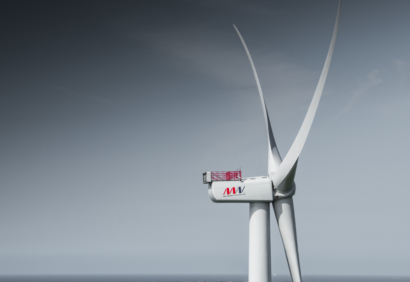forum
library
tutorial
contact

Wind Turbine; Shell
Looks to 10-Gigawatt Projects
by Stephen Lacey
Greentech Media, June 7, 2017
|
the film forum library tutorial contact |

|
Wind Turbine; Shell
by Stephen Lacey
|
The world's biggest wind companies push the envelope on turbine and project size.
 Danish wind manufacturer MHI Vestas launched a 9.5-megawatt offshore turbine this week. The machine is an upgrade from the company's 9-megawatt model released earlier this year.
Danish wind manufacturer MHI Vestas launched a 9.5-megawatt offshore turbine this week. The machine is an upgrade from the company's 9-megawatt model released earlier this year.
In January, Vestas reported that its new machine -- an 8-megawatt-capacity turbine that can be uprated to 9 megawatts at certain sites -- generated 216,000 kilowatt-hours of electricity in one day. That was a record for any commercial offshore wind turbine, according to the company.
Vestas also says its 9.5-megawatt model, which features blades that are 80 meters long, can produce enough electricity to power more than 8,000 U.K homes.
"With only minimal design changes, including a redesigned gearbox and cooling system upgrades, this turbine continues the legacy of the proven V164 platform and is available now to all MHI Vestas customers," said Torben Hvid Larsen, the company's chief technology officer, in a statement.
Vestas is at the leading edge of turbine design. Windpower Monthly has a list of the biggest turbines on the market today. The Vestas V164 8-megawatt model topped the rankings.
In less than a year, the V164 platform was expanded to 9.5 megawatts.
Manufacturers are regularly developing turbines rated in the 5- to 8-megawatt range. Some are already looking beyond 10-megawatt designs -- and researchers are even toying with the idea of 50-megawatt capacity turbines.
"For many years, 3- to 4-megawatt turbines were standard; now 8- to 10-megawatt models are common, and by 2024, 13- to 15-megawatt models will likely hit the market," wrote McKinsey researchers in a recent analysis on the economics of offshore wind.
"This reduces the cost per megawatt. Even as turbines have become larger, they have also become better. In the 1990s, the expected lifetime of offshore wind parks was only 15 years; now it is closer to 25 years, and new sites project an operational lifetime of 30 years."
Meanwhile, energy supermajors are looking to use those mega-turbines to build out mega-projects.
Shell said this week it is eyeing 10-gigawatt offshore wind parks, according to Recharge News.
"We believe that a few large, integrated projects up to 10 gigawatts, with an anchor tenant who takes the biggest risk for about half the project, need to be developed to ensure we all learn how best to do this" said Mark Gainsborough, the executive vice president of Shell New Energies, speaking at a European offshore wind conference.
Shell has an equity stake in half a dozen offshore wind farms around the world. In December, it partnered with Mitsubishi and a group of Danish companies to develop a 700-megawatt offshore project.
What's driving wind technology change? Listen to our Interchange episode with Ryan Wiser, who discusses the evolution of turbine size and applications.
learn more on topics covered in the film
see the video
read the script
learn the songs
discussion forum
